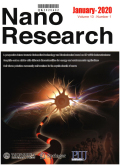- 钛学术文献服务平台 \
- 学术期刊 \
- 基础科学期刊 \
- 物理学期刊 \
- 纳米研究(英文版)期刊 \
Flexible synthesis of high-purity plasmonic assemblies
Flexible synthesis of high-purity plasmonic assemblies
基本信息来源于合作网站,原文需代理用户跳转至来源网站获取
摘要:
The self-assembly of nanoparticles has attracted a vast amount of attention due to the ability of the nanostructure to control light at the sub-wavelength scale,along with consequent strong electromagnetic field enhancement.However,most approaches developed for the formation of discrete assemblies are limited to a single and homogeneous system,and incorporation of larger or asymmetrical nanopartides into assemblies with high purity remains a key challenge.Hera,a simple and versatile approach to assemble nanopartides of different sizes,shapes,and materials into various discrete homo-or hetero-structures using only two complementary deoxyribonucleic acid (DNA) strands is presented.First,surface functionalisation using DNA and alkyl-polyethylene glycol (PEG)enables transformation of as-synthesised nanoparticles into readily usable plasmonic building blocks for self-assembly.Optimlsation of the DNA coverage enables the production of different assembly types,such as homo-and hetero-dimers,trimers and tetramers and core-satellite structures,which are produced in high purity using electrophoresis purification.The approach is extended from purely plasmonic structures to incorporate (luminescent) semiconductor nanopartides for formation of hybrid assemblies.The deposited assemblies form a high yield of specific geometrical arrangements,attributed to the van der Waals attraction between particles.This method will enable the development of new complex colloidal nanoassemblies for biological and optical applications.

推荐文章
Thermodynamic properties of San Carlos olivine at high temperature and high pressure
San Carlos olivine
Thermodynamic property
Thermal expansion
Heat capacity
Temperature gradient
Synthesis前兆群体异常信息提取与地震短期预测研究
地震前兆
群体异常
Synthesis法
信息提取
短期预报
Supreme与Flexible喉罩通气罩内压对气道漏气压的影响
喉罩
Supreme
Flexible
通气罩内压
WinCC flexible组态软件在砂光机控制系统中的应用
S7-200
砂光机
WinCC flexible
组态软件
内容分析
关键词云
关键词热度
相关文献总数
(/次)
(/年)
引文网络
引文网络
二级参考文献 (29)
共引文献 (0)
参考文献 (85)
节点文献
引证文献 (0)
同被引文献 (0)
二级引证文献 (0)
2001(2)
- 参考文献(1)
- 二级参考文献(1)
2002(3)
- 参考文献(2)
- 二级参考文献(1)
2003(1)
- 参考文献(1)
- 二级参考文献(0)
2004(3)
- 参考文献(2)
- 二级参考文献(1)
2005(2)
- 参考文献(1)
- 二级参考文献(1)
2006(3)
- 参考文献(2)
- 二级参考文献(1)
2007(6)
- 参考文献(2)
- 二级参考文献(4)
2008(3)
- 参考文献(3)
- 二级参考文献(0)
2009(5)
- 参考文献(2)
- 二级参考文献(3)
2010(4)
- 参考文献(2)
- 二级参考文献(2)
2011(7)
- 参考文献(4)
- 二级参考文献(3)
2012(8)
- 参考文献(4)
- 二级参考文献(4)
2013(12)
- 参考文献(8)
- 二级参考文献(4)
2014(10)
- 参考文献(7)
- 二级参考文献(3)
2015(11)
- 参考文献(10)
- 二级参考文献(1)
2016(14)
- 参考文献(14)
- 二级参考文献(0)
2017(5)
- 参考文献(5)
- 二级参考文献(0)
2018(9)
- 参考文献(9)
- 二级参考文献(0)
2019(5)
- 参考文献(5)
- 二级参考文献(0)
2020(1)
- 参考文献(1)
- 二级参考文献(0)
2021(0)
- 参考文献(0)
- 二级参考文献(0)
- 引证文献(0)
- 二级引证文献(0)
引文网络交叉学科
相关学者/机构
期刊影响力
纳米研究(英文版)
主办单位:
清华大学
出版周期:
月刊
ISSN:
1998-0124
CN:
11-5974/O4
开本:
出版地:
北京市海淀区清华大学学研大厦A座5-7层
邮发代号:
创刊时间:
语种:
eng
出版文献量(篇)
2324
总下载数(次)
1
总被引数(次)
5935
期刊文献
相关文献
推荐文献

 免费查重
免费查重










